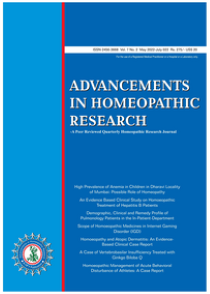Real-World Evidence on the Effectiveness of AlphaTM – Liv Sugar Free in Managing Sluggish Liver Functions And Fatty Liver: A Post-Marketing Physician Survey
DOI:
https://doi.org/10.48165/ahr.2025.10.3.1Keywords:
Alpha™-Liv Sugar Free, liver tonic, hepatoprotective, fatty liver, sluggish liver, real world evidence, post-marketing survey, homeopathic formulation, integrative medicineAbstract
Introduction: Liver dysfunction, including sluggish liver and fatty liver disease, poses a growing global health challenge, exacerbated by lifestyle factors and hepatotoxic exposures. Conventional therapies offer relief but are often limited by side effects, prompting increased interest in complementary hepatoprotective remedies. Alpha™-Liv Sugar Free Liver Tonic- a multi-ingredient homeopathic tonic, is known for its efficacy in management of liver diseases in diabetic patients. This study aimed to evaluate the real world effectiveness and safety of Alpha™-Liv Sugar Free Liver Tonic in managing functional hepatic disturbances. Methods & Methods: A post-marketing survey was conducted using a structured Google Form distributed to physicians across India. Data was collected on speed of action, clinical effectiveness, and adverse effects based on physicians’ experience with Alpha™- Liv Sugar Free Liver Tonic. Responses from 80 prescribing doctors were analyzed using descriptive statistics. Results: Of the respondents, 90% rated Alpha™-Liv Sugar Free Liver Tonic effectiveness between 4 and 5, indicating high therapeutic benefit. Over 93.75% observed symptomatic improvement within a week. A favorable safety profile was reported by 98.75% of physicians, with negligible adverse effects noted. Conclusion: Alpha™-Liv Sugar Free Liver Tonic demonstrates strong clinical acceptance for its effectiveness and rapid action in liver dysfunction management. Its multi-targeted homeopathic formulation and high tolerability make it a promising option in integrative hepatology.
References
Vos, T., Lim, S. S., Abbafati, C., Abbas, K. M., Abbasi, M., Abbasifard, M., Abbasi-Kangevari, M., Abbastabar, H., Abd-Allah, F., Abdelalim, A., & Abdollahi, M. (2020). Global burden of 369 diseases and injuries in 204 countries and territories, 1990–2019: A systematic analysis for the Global Burden of Disease Study 2019. The Lancet, 396(10258), 1204–1222.
World Health Organization. (2025). India: Country overview. data.who.int. Retrieved July 30, 2025.
Chakrabarti, S. K., & Chattopadhyay, D. (2025). Non-alcoholic fatty liver disease in India: Mechanisms and metabolic signatures. International Journal of Clinical Case Reports and Investigations, 2(2), 20.
Friedman, S. L. (2003). Liver fibrosis–from bench to bedside. Journal of Hepatology, 38, 38–53.
Moreau, R., Tonon, M., Krag, A., Angeli, P., Berenguer, M., Berzigotti, A., Fernandez, J., Francoz, C., Gustot, T., Jalan, R., & Papp, M. (2023). EASL Clinical Practice Guidelines on acute-on-chronic liver failure. Journal of Hepatology, 79(2), 461–491.
Flora, K., Hahn, M., Rosen, H., & Benner, K. (1998). Milk thistle (Silybum marianum) for the therapy of liver disease. The American Journal of Gastroenterology, 93(2), 139–143.
Hellerbrand, C., Schattenberg, J. M., Peterburs, P., et al. (2017). The potential of silymarin for the treatment of hepatic disorders. Clinical Phytoscience, 2(7). https://doi.org/10.1186/s40816-016-0019-2
Power, S., & Barritt, A. S. 4th. (2024). A yellow flower with jaundice power: Liver injury attributed to Greater Celandine. ACG Case Reports Journal, 11(5), e01347. https://doi.org/10.14309/crj.0000000000001347
Li, X., Yuan, W., Wu, J., Zhen, J., Sun, Q., & Yu, M. (2022). Andrographolide, a natural anti-inflammatory agent: An update. Frontiers in Pharmacology, 13, 920435. https://doi.org/10.3389/fphar.2022.920435
Yamaura, K., Shimada, M., Nakayama, N., & Ueno, K. (2011). Protective effects of goldenseal (Hydrastis canadensis L.) on acetaminophen-induced hepatotoxicity through inhibition of CYP2E1 in rats. Pharmacognosy Research, 3(4), 250–255. https://doi.org/10.4103/0974-8490.89745
Singh, A., Choudhary, R., & Ganguly, S. (2022). Podophyllin in dermatology: Revisiting a historical drug. Indian Dermatology Online Journal, 13(1), 167–171. https://doi.org/10.4103/idoj.idoj_225_21
Minton, N., Swift, R., Lawlor, C., Mant, T., & Henry, J. (1993). Ipecacuanha-induced emesis: A human model for testing antiemetic drug activity. Clinical Pharmacology & Therapeutics, 54(1), 53–57. https://doi.org/10.1038/clpt.1993.109
Homoeopathic Pharmacopoeia of India. Department of AYUSH, Ministry of Health and Family Welfare, Government of India.
Hepatoprotective activity of homeopathic formulation AlphaTM-Liv Drops in rat model. (2024). Advancements in Homeopathic Research, 9(2), 3–8. Retrieved August 4, 2025, from https://journals.acspublisher.com/index.php/ahr/article/view/15303
Federico, A., Dallio, M., & Loguercio, C. (2017). Silymarin/silybin and chronic liver disease: A marriage of many years. Molecules, 22(2), 191.
Zielińska, S., Jezierska-Domaradzka, A., Wójciak-Kosior, M., Sowa, I., Junka, A., & Matkowski, A. M. (2018). Greater celandine’s ups and downs−21 centuries of medicinal uses of Chelidonium majus from the viewpoint of today’s pharmacology. Frontiers in Pharmacology, 9, 299.
Jayakumar, T., Hsieh, C. Y., Lee, J. J., & Sheu, J. R. (2013). Experimental and clinical pharmacology of Andrographis paniculata and its major bioactive phytoconstituent andrographolide. Evidence-Based Complementary and Alternative Medicine, 2013(1), 846740.
Habtemariam, S. (2016). Berberine and inflammatory bowel disease: A concise review. Pharmacological Research, 113, 592–599.




